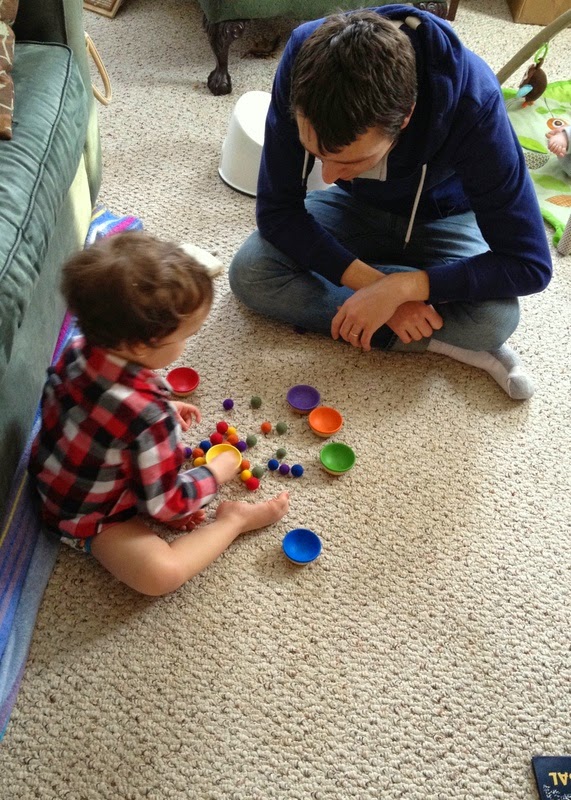As we neared the end of another box of Mrs. Meyers Dryer sheets, I started wondering about alternatives. The dryer sheets we used aren't full of chemicals, and are eco-friendly, but they are expensive to buy box after box. Plus, you can't use dryer sheets with cloth diapers, and we wash diapers every other day! After reading all about wool dryer balls, I decided that was the perfect option for our family. Here is why:
1. Wool dryer balls are reusable. You can use the same set of dryer balls every time you use the dryer and they can potentially last decades. This means not only are you producing less waste (eco-friendly), you also are saving lots of money!
2. Wool dryer balls decrease drying time. The wool helps to absorb moisture from your laundry and people have said that dryer balls drastically cut down their drying time (usually about 75% as long). This will make your electric bill cheaper, and also better for the environment.
3. Wool dryer balls cut down on static, just like dryer sheets. If you dry your clothes for too long, the balls can carry a static charge, so if you find that your clothes are staticky with wool dryer balls, try reducing your drying time.
4. Wool dryer balls soften your laundry while they bounce around in the dryer.
5. Wool dryer balls are sustainably made. They are also free of harmful chemicals, and wonderfully safe for pets and children.
Feeling ambitious, I decided to make some of my own wool dryer balls, as I thought it would be a fun activity to do with my boys. I made mine by felting balls from wool batting, as this methods makes balls that are able to absorb more moisture, hold together longer (ones made from yard tend to unravel over time), and are quieter in the dryer. So we purchased some 100% organic wool batting from an Etsy shop, which was wonderfully soft and smelled mildly of sheep.
Here's how we made them:
1. I cut strips of wool batting and wound the strips tightly into a ball. After winding each strip, I used a felting needle to secure the wool into a ball shape.
2. I stopped winding the ball once it was roughly the size of a softball.
3. I put the balls in nylon stockings.
4. Then I began the felting process. I put the balls into the washer and washed them on hot with a little Eco-friendly laundry detergent. Then I dried them on hot. When I took them out, the balls had felted to the nylon quite a bit, and it was a process to cut them out. Seriously, this was a pain in the butt. We tried using scissors, an X-acto knife, and even little sharp thread snippers. My husband discovered the best method was to cut the wool that was outside the nylon with scissors and then attempt to peel away the nylon in sections. No matter what, this process took a long time. I think if I spent more time felting them with a needle before putting them into a nylon, this process wouldn't be so tedious, but I'm not sure.


5. At this point, you repeat the felting process two more times to ensure the wool balls hold together for many years. So you put the balls into new nylons (they won't felt onto them anymore so you will be able to reuse them for the third wash), wash them and dry them again, then repeat the process for a third time. You may want to reshape the balls with your hands to ensure they stay nice and round if you care about that.
The dryer balls shrink down quite a bit in the process, but still end up being larger than tennis balls.
To add color, you felt wool roving onto the ball with felting needles after the first wash/dry cycle. Once the color is added, you continue with two more wash/dry cycles just as described above. I got some beautiful wool roving (
Felt Evolution Etsy Shop) in two different colors to felt onto my balls.
The first set was inspired by Monet's Waterlilies Painting:
The second set was inspired by the colors of a sunset:
I am pleased how these wool balls turned out. I really enjoyed felting colors onto the ball, as it was something I had never done before and it was fun to design them. They have been working well too; our clothes have been soft and not clingy. The dryer balls themselves have also held up wonderfully.
Note: After making many more wool balls, I've found that the longer I spend jabbing at them with a felting needle, the easier they are to remove from the nylons! In fact, if felted with a needle well enough prior to starting the wash felting process, I was able to peel the balls right out of the nylons without even using scissors or a knife! The whole process was made MUCH, MUCH less time consuming!



















































